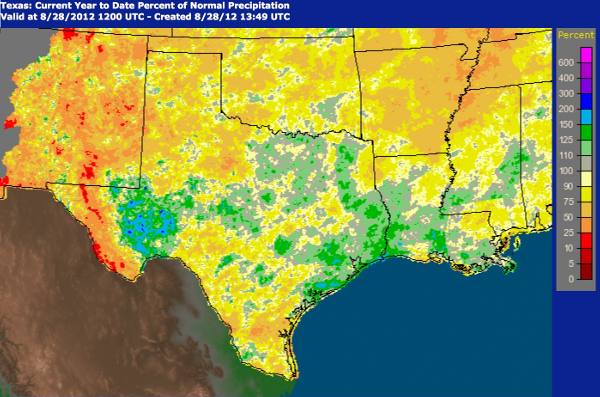August 28, 2012

According to National Weather Service records, large areas of the state have received 100 percent or more of normal rainfall since Jan. 1. Many other areas have gotten 50 to 75 percent of normal.
The precipitation statistics aside, much of Texas still suffers from drought conditions, according to Texas AgriLife Extension Service personnel. Of concern to many are low pond and stock-tank levels. Conditions often vary county to county within a region.
For example, though most of East Texas is officially out of the drought, pockets of abnormally dry weather still exist.
According to the service, Marion County has received about 75 percent of normal rainfall for the year, but you couldn’t tell it by local conditions, said Brock Fry, AgriLife Extension agent for Marion County, northeast of Longview. Many ponds there are dry or down about 6 feet, creating issues for livestock producers, even though herd inventories are down by about 50 percent.
Rocky Vinson, AgriLife Extension agent for Shackelford County, north of Abilene, reported about 3 inches of rain fell there in the last week. Though the rain helped the soil moisture situation, stock tanks remained very low.
West of Fort Worth, Stephens County also received some much-needed rain this week, from 0.5 to 1 inch, but conditions are so dry, much more rain is needed to fill tanks, ponds and lakes to standard levels, according to Leslie Neve, AgriLife Extension agent for Stephens County.
From South Texas, George Gonzales, AgriLife Extension agent for Webb County, reported high temperatures continued to run in the 100-degree-plus range last week, and evaporation rates were very high. Most ponds remained completely dry or were about to go completely dry. Webb County has had 50 to 75 percent of normal rainfall for the year, according to the weather service.
There’s a simple reason ponds and reservoirs remain low in many areas despite considerable rainfall this year, said Dr. John Nielsen-Gammon, state climatologist and Regents professor at Texas A&M University.
Soils are extremely dry deep down and soak up any rain received before it can runoff to fill ponds and reservoirs, he said.
More information on the current Texas drought and wildfire alerts can be found on the AgriLife Extension Agricultural Drought Task Force website at http://agrilife.tamu.edu/drought/.
You May Also Like




